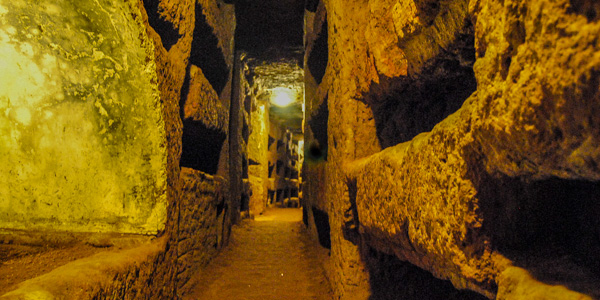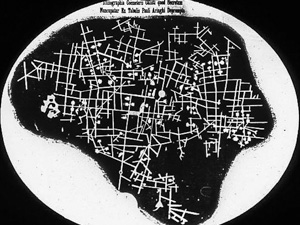

Burials were forbidden within the city walls of ancient Rome as early as the 5th century BC. The Romans—pagan and, later, Christian, began a habit of burying their dead along and around the Via Appia Antica, the Ancient Appian Way, one of the major consular roads connecting Rome with the Adriatic seaports of the south.
Though most patrician Romans built their tombs aboveground, the early Christians hewed miles of tunnels—or catacombs—out of the soft tufa stone beneath the surface to bury their dead and, during the worst times of persecution, hold church services discreetly out of the public eye.
A few of the catacombs are now open to the general public (see below), so you can wander through mile after mile of musty-smelling tunnels whose soft walls are gouged out with tens of thousands of burial niches—long shelves made for two or three each.
The requisite guided tours, hosted mainly by priests or monks, feature a smidgen of extremely biased history and a large helping of sermonizing.
You could just pick one, though visiting two would give you some perspective (and variety). If I had to pick two to pair up, it would be San Domitilla and San Callisto.
View information for each Catacomb at their designated site:
St. Calixtus: www.catacombe.roma.it
San Domitilla: www.domitilla.info
St. Sebastian: www.catacombe.org
Planning your day: Even if you're just riding a bus out here to explore one set of catacombs, figure on it taking half the day (2.5 hours at the very least, including transport).
If you want to see all of the catacombs (plus the other Appian Way sights), give it a full day—and have lunch at Hostaria L'Archeologia.
Take a guided tour of the Catacombs with one of our partners:
Although each of the three major catacombs keeps the same open hours (9am–noon and 2–5pm) and charges the same admission (€8 each), they all close on a different day of the week:
So if you are gung-ho about it and want to hit all three, make sure you visit on a day when all three are open. (This, actually, is quite wise of them; that way, no matter which day you visit, at last two will be open.)
These sights aren't terribly close to the rest of Rome. If you want to make a day dedicated to the outskirts of the wall, these are the places to see:
Share this page
Search ReidsItaly.com